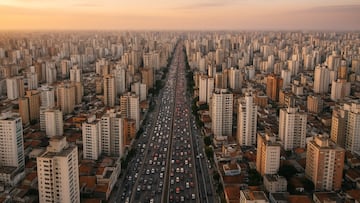‘The human anthill’: the city with almost 35,000 inhabitants per square mile
Packed to the brim with people, this South American metropolis is one of the world’s most densely populated urban areas.

With a population of 273,542, Taboão da Serra has officially become the most densely populated municipality in Brazil. Although it’s the ninth-smallest in the country, covering just 7.7 square miles (20 square kilometers), the city squeezes in an astonishing 34,700 residents per square mile, according to data from Brazil’s Institute of Geography and Statistics (IBGE).
City officials expect the population to rise to roughly 285,000 by the end of 2025, driven largely by working residents drawn to its proximity to São Paulo. As the population grows, the demand for infrastructure and public services continues to surge. The challenge lies in the lack of space: of the city’s 7.7 square miles, 7.2 are already completely urbanized.
No room to grow
There’s almost no land left for new roads or buildings. Streets are crowded, noise fills the air, and the population density shows no sign of easing. That’s hardly surprising - Taboão da Serra sits in the state of São Paulo, a sprawling metropolis with a population density of around 20,000 people per square mile. Its location just outside the capital has turned it into a magnet for thousands seeking more affordable housing within commuting distance of São Paulo.
From farmland to high-rises
Taboão da Serra began taking shape in the early 20th century, originally as a small agricultural community. But as São Paulo expanded, farmland gave way to residential and commercial zones designed to offer a better quality of life at lower housing costs. Its strategic position, between São Paulo’s industrial and residential belts, made it especially attractive to workers seeking shorter commutes.
With only 7.7 square miles to work with, the city turned upward instead of outward. Vertical construction became the cornerstone of its urban development. By the early 2000s, agriculture had been completely replaced by services and major retail chains like Grupo Pão de Açúcar, Carrefour, and Walmart. The result, according to French outlet Linternaute, is a “human anthill” of activity.
Building a livable future
Even as the density keeps climbing, local leaders are now focused on improving residents’ quality of life. Plans include expanding green spaces, schools, and health centers to meet the growing population’s needs. The city is also prioritizing mixed-use developments and better public transportation to make everyday life more sustainable in one of the most crowded places in the Americas.
Related stories
Get your game on! Whether you’re into NFL touchdowns, NBA buzzer-beaters, world-class soccer goals, or MLB home runs, our app has it all.
Dive into live coverage, expert insights, breaking news, exclusive videos, and more – plus, stay updated on the latest in current affairs and entertainment. Download now for all-access coverage, right at your fingertips – anytime, anywhere.
Complete your personal details to comment